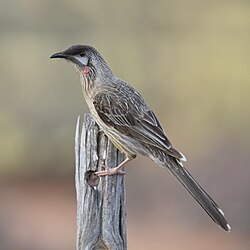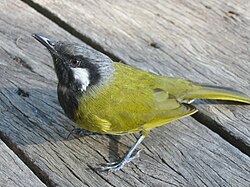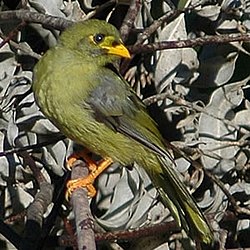Honey eater
| Honey eater | ||||||||||||
|---|---|---|---|---|---|---|---|---|---|---|---|---|

Tui ( Prosthemadera novaeseelandiae ) |
||||||||||||
| Systematics | ||||||||||||
|
||||||||||||
| Scientific name | ||||||||||||
| Meliphagidae | ||||||||||||
| Vigors , 1825 |
The honey-eaters (Meliphagidae) form a species-rich family in the order of the passerine birds (Passeriformes). Depending on the author, the family includes 172 to 182 species in 42 genera. Most species of this family of songbirds are characterized by their long, forward curved beak, which is excellent for feeding pollen and honey.
features
The body size and beak shape of the different types of honeyeater can vary widely. The plumage color also has a wide spectrum. They have a long tongue that is adapted to their diet. The tongue can be stretched out far and is split at the tip and equipped with numerous fringes. The nectar is caught like a brush . The ingestion of the nectar is facilitated by the tongue curled up at the base of the tongue.
The chants are mostly used to delimit the territory and can be very impressive, as with the honey tasters ( Melithreptus ). The tui , also known as the priest bird because of its white feathers on its neck, has the ability not only to imitate the songs of different species of songbirds, it can also imitate the voices of other animals.
nutrition
They feed like sunbirds of pollen and nectar, and the role take over at some plants the pollen transfer agent. Insects, berries and fruits are also on the menu.
Reproduction
The nests with one or two eggs are usually bowl-shaped, open or closed at the top and have a side entrance. They are applied to trees and bushes. They use grass, bark, plant fibers or moss, ferns, leaves and twigs to build nests.
distribution
Honeyeater are common in many different habitats in Australia , New Guinea , some of the Lesser Sunda Islands , New Zealand and many islands in the South Pacific , and mostly inhabit trees.
Existence and endangerment
The Chatham bell honey eater ( Anthornis melanocephala ), which was at times considered a subspecies of the Maori bell honey eater ( Anthornis melanura ), was last sighted in 1906. Several species listed as endangered by BirdLife International have a very small range and are threatened by habitat loss. These include the mallee chatterbox , the wart honey eater , the mao honey eater , the red-faced honey eater and the morotaile head . In 2000, fewer than 100 individuals were counted, including 37 breeding pairs, of the Australian tufted ear honey eater ( Lichenostomus melanops cassidix ), a subspecies of the yellow-headed honey eater ( Lichenostomus melanops ).
Changes in the system
In recent years there have been several taxonomic changes within the honeyeater family. Originally the New Zealand stinging bird or hihi ( Notiomystis cincta ) belonged to this family. However, genetic analyzes revealed a closer relationship to the lobed birds , so that in 2007 it was placed in the independent family Notiomystidae . The new Mohoidae family was created in 2008 for five extinct taxa - the narrow- feather honey-eater ( Chaetoptila angustipluma ) and all four species of curly-tailed (Moho) - because these birds do not descend from Australian honey-eaters, as mistakenly assumed, but from New World relatives of the waxwings , which reached the Hawaiian Islands over 17 million years ago. Two species of spectacled bird - the golden- eyed bird ( Cleptornis marchei ) and the Bonin- eyed bird ( Apalopteron familiare ) - were also previously regarded as representatives of honey-eaters. The lobed honey eater ( Macgregoria pulchra ) was originally considered a bird of paradise . On the basis of molecular studies that suggest similarities with the honey-eaters of the genus Melipotes , it was transferred to the honey-eaters family in 2000. The African protea birds (Promeropidae), which were either considered to be a subfamily of the nectar birds or the honeyeater, have been regarded as an independent family since 2005. The taxonomic position of the black wheatear was also unclear for a long time. They were classified either as representatives of the thrushes or as a separate family Ephthianuridae. According to current researcher opinion, the two genera of the black wheatear now belong to the honey eaters.
Genera and species













-
Acanthagenys
- Brown-throated honeyeater ( Acanthagenys rufogularis )
-
Acanthorhynchus
- Spotted honeyeater ( Acanthorhynchus superciliosus )
- Red-necked honeyeater ( Acanthorhynchus tenuirostris )
-
Anthochaera
- Anthochaera lunulata
- Yellow-lobed honeyeater ( Anthochaera paradoxa )
- Red-rag honeyeater ( Anthochaera carunculata )
- Cinnamon-wing honeyeater ( Anthochaera chrysoptera )
-
Anthurium
- Maori bell honeyeater ( Anthornis melanura )
- † Chatham bell honeyeater ( Anthornis melanocephala )
-
Ashbyia
- Desert wheatear ( Ashbyia lovensis )
-
Certhionyx
- Chest band honeyeater ( Certhionyx pectoralis )
- Elster Honigfresser ( Certhionyx variegatus )
- Black honey eater ( Certhionyx niger )
-
Conopophila
- Gray honey eater ( Conopophila whitei )
- Rust band honeyeater ( Conopophila albogularis )
- Rust-throated honeyeater ( Conopophila rufogularis )
-
Entomyzon
- Blue-eared honeyeater ( Entomyzon cyanotis )
-
Epthianura
- Gold-browed wheatear ( Epthianura aurifrons )
- Short-tailed wheatear ( Epthianura albifrons )
- Safrantrugschmätzer ( Epthianura crocea )
- Scarlet wheatear ( Epthianura tricolor )
-
Foulehaio
- Scaly head honeyeater ( Foulehaio carunculatus )
-
Glycifohia
- Sperber Honigfresser ( Glycifohia undulata )
- White-bellied honeyeater ( Glycifohia notabilis )
-
Glyciphila
- Gold- crowned honeyeater ( Glyciphila melanops )
-
Grantiella
- Grant honeyeater ( Grantiella picta )
-
Guadalcanaria
- Guadalcanal honeyeater ( Guadalcanaria inexpectata )
-
Gymnomyza
- Red-faced honeyeater ( Gymnomyza aubryana )
- Olive honey eater ( Gymnomyza brunneirostris )
- Maohonigfresser ( Gymnomyza samoensis )
- Green honey eater ( Gymnomyza viridis )
-
Lichenostomus
- Great Beaked Honeyeater ( Lichenostomus frenatus )
- Three-striped honeyeater ( Lichenostomus chrysops )
- Eungella honey eater ( Lichenostomus hindwoodi )
- Yellow-throated honeyeater ( Lichenostomus flavicollis )
- Yellow-crowned honeyeater ( Lichenostomus ornatus )
-
Yellow-headed honey eater ( Lichenostomus melanops )
- Tufted Ear Honeyeater ( Lichenostomus melanops cassidix )
- Gilb Honeyeater ( Lichenostomus flavescens )
- Golden Stripe Honeyeater ( Lichenostomus subfrenatus )
- Gray-headed honeyeater ( Lichenostomus keartlandi )
- Green peak-Honigfresser ( Lichenostomus plumulus )
- Deciduous honey eater ( Lichenostomus obscurus )
- Mangrove honeyeater ( Lichenostomus fasciogularis )
- Olive-throated honeyeater ( Lichenostomus fuscus )
- Whistling honey eater ( Lichenostomus virescens )
- Golden Oriole Eater ( Lichenostomus versicolor )
- Crimson Honeyeater ( Lichenostomus cratitius )
- Black-throated honeyeater ( Lichenostomus leucotis )
- Temminck honeyeater ( Lichenostomus reticulatus )
- White rump honeyeater ( Lichenostomus penicillatus )
- Amidora ( Lichenostomus unicolor )
- Lemon Honeyeater ( Lichenostomus flavus )
-
Lichmera
- Lichmera limbata
- Brown honey eater ( Lichmera indistincta )
- Buru honey eater ( Lichmera deningeri )
- Finsch honeyeater ( Lichmera notabilis )
- Gray-eared honeyeater ( Lichmera incana )
- Lombok honeyeater ( Lichmera lombokia )
- Ear patch honeyeater ( Lichmera alboauricularis )
- Salvadoran honeyeater ( Lichmera squamata )
- Seram Honeyeater ( Lichmera monticola )
- Silver- eared honeyeater ( Lichmera argentauris )
- Timor Honeyeater ( Lichmera flavicans )
-
Macgregoria
- Lobed honeyeater ( Macgregoria pulchra ).
-
Babbling birds ( Manorina )
- Yellow-fronted babbler ( Manorina flavigula )
- Bell-babbling bird ( Manorina melanophrys )
- Mallee babbler ( Manorina melanotis )
- White-fronted babbler ( Manorina melanocephala )
-
Meliarchus
- Stainless tail Honigfresser ( Meliarchus sclateri )
-
Melidectes
- Belford honeyeater ( Melidectes belfordi )
- Purple wart honeyeater ( Melidectes fuscus )
- Diadem honeyeater ( Melidectes leucostephes )
- Foerster honey eater ( Melidectes foersteri )
- Gilliard honeyeater ( Melidectes whitemanensis )
- Short-bearded honeyeater ( Melidectes nouhuysi )
- Long-bearded honeyeater ( Melidectes princeps )
- Reichenow honeyeater ( Melidectes rufocrissalis )
- Rost-eared honeyeater ( Melidectes ochromelas )
- Cinnamon Breast Honeyeater ( Melidectes torquatus )
-
Melilestes
- Long-billed honeyeater ( Melilestes megarhynchus )
-
Meliphaga
- Aruhonigeater ( Meliphaga aruensis )
- Mountain forest honeyeater ( Meliphaga montana )
- Fairy Honeyeater ( Meliphaga gracilis )
- Yellow-chin honeyeater ( Meliphaga flavirictus )
- Golden-eared honeyeater ( Meliphaga lewinii )
- Mimika-Honigfresser ( Meliphaga mimikae )
- Papuan honey eater ( Meliphaga analoga )
- Snow-eared honeyeater ( Meliphaga albonotata )
- Tagula honeyeater ( Meliphaga vicina )
- Torresh Honeyeater ( Meliphaga notata )
- Whitebeard honeyeater ( Meliphaga albilineata )
-
Melipotes
- Ash breast honeyeater ( Melipotes fumigatus )
- Spot abdominal Honigfresser ( Melipotes gymnops )
- Huon honey eater ( Melipotes ater )
- Carolahoney Eater ( Melipotes carolae )
-
Honey Gourmet ( Melithreptus )
- Brown-headed honey taster ( Melithreptus brevirostris )
- Golden back honey tasters ( Melithreptus laetior )
- Moonstripe Honey Gourmet ( Melithreptus lunatus )
- Black-chin honey taster ( Melithreptus gularis )
- Schwarzkopf honey taster ( Melithreptus affinis )
- Rough-billed honey tasters ( Melithreptus validirostris )
- White-chin honey taster ( Melithreptus albogularis )
-
Melitograis
- Halmahera leather head ( Melitograis gilolensis )
-
Myza
- Celebes honeyeater ( Myza celebensis )
- Sarasin honeyeater ( Myza sarasinorum )
-
Myzomela
- Island honeyeater ( Myzomela boiei )
- New Caledonia honeyeater ( Myzomela caledonica )
- Crimson Honeyeater ( Myzomela chermesina )
- Sulawesi honeyeater ( Myzomela chloroptera )
- Sumba honeyeater ( Myzomela dammermani )
- Ebony Honeyeater ( Myzomela pammelaena )
- Micronesia honeyeater ( Myzomela rubratra )
- Wakolo honey eater ( Myzomela wakoloensis )
- Amboina honeyeater ( Myzomela blasii )
- Arfak honeyeater ( Myzomela adolphinae )
- Blood honey eater ( Myzomela cruentata )
- Tricolor honeyeater ( Myzomela vulnerata )
- Flamehead honeyeater ( Myzomela erythromelas )
- Cardinal honeyeater ( Myzomela cardinalis )
- Malaita honeyeater ( Myzomela malaitae )
- Carrot Honeyeater ( Myzomela nigrita )
- New Ireland Honeyeater ( Myzomela pulchella )
- Orange-breasted honeyeater ( Myzomela jugularis )
- Palakuru honey eater ( Myzomela sclateri )
- Rosenberg honeyeater ( Myzomela rosenbergii )
- Red rump honeyeater ( Myzomela eichhorni )
- Redhead honeyeater ( Myzomela erythrocephala )
- Soot honey eater ( Myzomela obscura )
- Scarlet Honeyeater ( Myzomela sanguinolenta )
- Scarlet- neck honeyeater ( Myzomela lafargei )
- Plain honeyeater ( Myzomela cineracea )
- Tristram honeyeater ( Myzomela tristrami )
- White-chin honeyeater ( Myzomela albigula )
- Wetar honeyeater ( Myzomela kuehni )
-
Oreornis
- Golden-cheeked honeyeater ( Oreornis chrysogenys )
-
Leather heads ( Philemon )
- Gray leather head ( Philemon kisserensis )
- Philemon Yorki
- Burleather head ( Philemon moluccensis )
- Cockerell leather head ( Philemon cockerelli )
- Squirrel leather head ( Philemon eichhorni )
- Smooth-forehead leather head ( Philemon citreogularis )
- Helmet leather head ( Philemon buceroides )
- Noise leather head ( Philemon corniculatus )
- Lesson leather head ( Philemon diemenensis )
- Mamberano leather head ( Philemon brassi )
- Manus leather head ( Philemon albitorques )
- Morotail head ( Philemon fuscicapillus )
- Papu leather head ( Philemon novaeguineae )
- Seram leather head ( Philemon subcorniculatus )
- Timor leather head ( Philemon inornatus )
- White-parted leather head ( Philemon argenticeps )
- Dwarf leather head ( Philemon meyeri )
-
Phylidonyris
- Golden-winged honeyeater ( Phylidonyris pyrrhopterus )
- White-eyed honeyeater ( Phylidonyris novaehollandiae )
- White-eared honeyeater ( Phylidonyris nigra )
- White- browed honeyeater ( Phylidonyris albifrons )
-
Plectorhyncha
- Honey eater ( Plectorhyncha lanceolata )
-
Prosthemadera
- Tui ( Prosthemadera novaeseelandiae )
-
Ptiloprora
- Ptiloprora mayri
- Lead-throated honeyeater ( Ptiloprora plumbea )
- Meekhonigfresser ( Ptiloprora meekiana )
- Red-flanked honeyeater ( Ptiloprora erythropleura )
- Red- back honeyeater ( Ptiloprora guisei )
- Striped honey eater ( Ptiloprora perstriata )
-
Pycnopygius
- Bulbülhonigfresser ( Pycnopygius ixoides )
- Marble Honeyeater ( Pycnopygius cinereus )
- Strichelkopf-Honigfresser ( Pycnopygius stictocephalus )
-
Ramsayornis
- Marsh honeyeater ( Ramsayornis modestus )
- Shaft breast Honigfresser ( Ramsayornis fasciatus )
-
Stresemannia
- Bougainville honey eater ( Stresemannia bougainvillei )
-
Timeliopsis
- Busch Honigfresser ( Timeliopsis fulvigula )
- Straight-billed honeyeater ( Timeliopsis griseigula )
- Green- mantled honeyeater ( Timeliopsis fallax )
-
Trichodere
- Shore Honeyeater ( Trichodere cockerelli )
-
Xanthomyza
- Warts Honigfresser ( Xanthomyza phrygia )
-
Xanthotis
- Bluebird Honeyeater ( Xanthotis polygrammus )
- Golden-eyed honeyeater ( Xanthotis provocator )
- Cap Honigfresser ( Xanthotis macleayanus )
- Ockerbrust-Honigfresser ( Xanthotis flaviventer )
Individual evidence
- ↑ J. Del Hoyo, A. Elliot and D. Christie (Eds.): Handbook of the Birds of the World. Volume 13: Penduline-Tits to Shrikes . Lynx Edicions, 2008, ISBN 978-84-96553-45-3
- ^ Robert C. Fleischer, Helen F. James, Storrs L. Olson (2008): Convergent Evolution of Hawaiian and Australo-Pacific Honeyeaters from Distant Songbird Ancestors. Current Biology, Volume 18
literature
- Publisher: Forshaw, Joseph: Encyclopedia of Birds , 1999 - ISBN 3-8289-1557-4
- J. del Hoyo, A. Elliott & DA Christie (Eds.) (2008): Handbook of the Birds of the World . Vol. 13. Penduline-Tits to Shrikes . Lynx Edicions, Barcelona, ISBN 978-84-96553-45-3